A student contribution to the REU blog.
In moderation, eating salt-laden junk food is not terrible; however, eating too much salt can have serious consequences for our health. The same is true for the environment. Too much salt is a very bad thing.
A watershed is an area of land wherein all the streams and small waterbodies flow into a common, larger body of water like a river or bay. When we feed our watersheds too much ‘junk food’ in the form of excess fertilizer and road salt, the water can become unhealthy and pose larger ecological problems.
Too much fertilizer flowing into a water body can increase nitrate levels and cause eutrophication. Like eating too much ice cream, eutrophication is essentially too much of a good thing. Nutrients are needed to feed plants, so we tend to think of nutrients as good. But high concentrations of nutrients can cause ecosystem imbalances. Excess nutrients are swept into bodies of water with precipitation; there, they feed algae, which can form large algal blooms. These blooms block sunlight, preventing photosynthesis in aquatic plants. When plants do not have enough light, they eventually die. Bacteria in the water digest the dead plants, a process which involves absorbing oxygen and emitting carbon dioxide. When there is no more oxygen in the water, aquatic animals, like fish, perish.
Salt flowing off roads from winter deicing efforts can increase salinity levels in surrounding bodies of water and threaten aquatic life. Like with fertilizer, the road salt we use for deicing washes into watersheds as runoff. Sodium chloride road salt works to prevent the formation of ice crystals by lowering the freezing point of water. While road salt prevents dangerous driving conditions, dumping tons of salt onto our roads makes freshwaters salty. When there is too much salt in the water, freshwater organisms are not able to maintain healthy levels of salt and other solutes in their bodies, and die as a result.
Researchers with the Baltimore Ecosystem Study (BES), a long-term ecological research site based in Baltimore, Maryland, have been collecting information on sodium chloride (road salt) and nitrate (fertilizer) concentrations in watersheds outside of suburban Baltimore for over two decades. This summer, I used this data to look at the relationship between chloride and nitrate levels in Baltimore County watersheds and the amount of fertilizer and road salt being applied by homeowners and municipalities.

Exurban areas lie beyond suburbs and are often understudied. Taking a closer look at these areas reveals clear evidence of human influence – even in areas with low population density and limited roads and infrastructure. The water samples that I studied this summer came from Baisman Run, an exurban watershed, and Pond Branch, a forested watershed. We found that chloride and nitrate concentrations are significantly higher in the exurban watershed, which is more densely populated than the forested site.
Additionally, we found that while the amount of road salt being used each winter has not increased significantly over the past two decades, the amount of chloride in the exurban watershed has increased. This indicates that chloride is accumulating in the water.
Nitrate levels at the exurban watershed have not increased significantly, but they have remained at an extremely high level. This is a sign of nitrate retention. It is clear that both salt and fertilizer are accumulating in these systems; these substances don’t just wash away.
To protect the watersheds of Baltimore County, we need to think about ways to reduce salt and nitrate flowing into Baltimore waterways. This starts with understanding the long-term effects of elevated salt and nitrate levels on watersheds in Baltimore County, as well as watersheds facing similar problems across the country. Since we rely on road salt and fertilizer to maintain safe winter roads and grow vivacious plants, we need to consider alternatives that carry less risk to the environment, along with potential barriers to implementation.
Like with food, access to healthier alternatives is a matter of expense. Food that is lower in sugar, fat and salt is generally better for us, but tends to be more expensive than food with less nutritional value. The same is true for deicers and fertilizers. Some alternatives to sodium chloride road salt have been studied – and work. These include snow melt mats, potassium chloride, and cat litter. When it comes to fertilizers, there are many organic options that are slower-acting than synthetics. They are effective in gardens, but are less likely to leach in quantities that would deliver a nutrient jolt to the surrounding ecosystem.
Unfortunately, while many of the alternatives are better for the environment, they tend to be very expensive and are therefore not feasible options for all communities. Similar to how socioeconomic status influences access to healthy foods, watershed health is determined by whether communities can afford eco-friendly alternatives for deicing their roads and feeding their plants.
This may seem like an overwhelming problem, but there are many creative and passionate minds working to find solutions. Viable alternatives for deicers and fertilizers are in hand; now we need to find ways to make these healthy options accessible for all communities.
Emma Castiblanco, a student at Haverford College, participated in Cary Institute's 2020 Research Experiences for Undergraduates (REU) program. This summer, Emma worked with Cary scientist Peter Groffman to study effects of road salt and nitrogen pollution on streams in Baltimore, Maryland.








